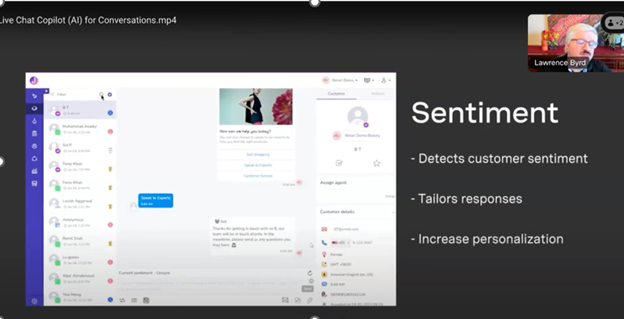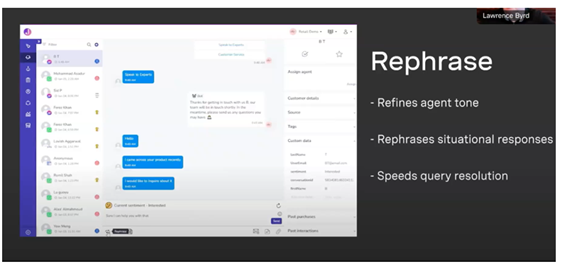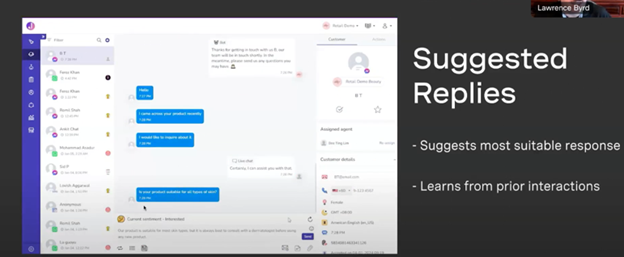Home > Columns > Executive Interviews
Vonage Executive Interview

Lawrence Byrd, Senior Director of Communications APIs, Vonage
Sheri
Greenhaus, Managing Partner, CrmXchange, sat down with Lawrence Byrd, Senior
Director of Communications APIs, Vonage. Vonage, a trailblazer in innovative communication
solutions, is at the forefront of transforming customer engagement and commerce.
With recent announcements in Vonage’s offering for conversational commerce, and
cutting-edge AI technology, the company is empowering organizations to connect
with customers seamlessly across various channels.
Sheri
Greenhaus: Can you tell us what is new at Vonage?
Lawrence
Byrd: Certainly. At
Vonage, we provide foundational communications applications, APIs, and tools
for organizations striving for innovation. Two significant areas of focus are
social engagement, particularly in marketing and conversational commerce, and
the practical use of AI to enhance customer experiences and processes.
Sheri:
Our audience is eager for ideas on enhancing customer satisfaction and
streamlining operations. They're also keen on tools to support agents, and AI
is top of mind for everyone.
Lawrence: AI is ubiquitous, akin to
electricity. The question is, what do we do with it? At Vonage, we've invested
heavily in virtual agents and conversational AI, irrespective of the contact
center or business infrastructure in place. Our approach is versatile; you can
access our solutions as a fully managed service or through self-service access
to the underlying tools, such as our AI Studio no-code conversation builder. We
provide services from conversational designers to professional services teams,
integrating seamlessly with platforms like Salesforce. Our focus is on
enriching customer interactions in real-time across the range of communications
channels, be it voice, WhatsApp, SMS, or video.
Sheri:
Many companies excel at building efficient self-service apps but struggle to
foster meaningful relationships with customers. How do we bridge this gap?
Lawrence: One key is transitioning towards
more social channels to initiate personalized longer-term conversations. This
is where our Vonage Conversational Commerce application platform extension
comes into play. This originated from our acquisition of Jumper.ai in 2021 and
has evolved to facilitate rich conversations on social media, particularly
increasing the effectiveness of online advertising. Take for example, HolidayPirates
(case study) a company internationally offering great travel deals. While
consumers are intrigued by these offers, they often require personalized
interactions to answer questions and seal the deal. Traditionally, companies
may have relied on one-way blasts, then expecting customers to navigate through
web pages. Now, with our conversational commerce application, these companies
can deploy bots to provide tailored information and seamlessly transition
customers to live agents, when needed for transaction completion. Message-based
marketing also makes it easier for your own customers to re-promote your
content, and get rewarded for this, adding a reference-marketing amplifier.
Our Vonage
conversational commerce platform offers comprehensive solutions across all social
channels. It seamlessly integrates with e-commerce and CRM systems, comprehends
inventory and pricing details, and showcases product visuals. It facilitates
efficient communication and transactions.
Prominent
brands such as Samsung in Asia Pacific and others
are diving into direct-to-consumer marketing, aiming to foster relationships
with customers upon launching new offers. Leveraging social media platforms
like Meta, with WhatsApp, Facebook and Messenger, they create targeted messages
and ads to engage their audience.
At the
recent Enterprise Connect event in Orlando in March, we unveiled AI enhancements
to elevate the user experience. This includes integrating generative AI to
empower agents with live assistant support and help marketers create better
promotional content. This innovative feature assists agents in refining
communication, provides helpful suggestions, and offers chat summarization for
seamless continuity. Termed as "co-pilots" or AI Assistants, these
capabilities are seamlessly integrated into our conversational commerce
experience across messaging channels for effective marketing and sales
endeavors. We are also expanding our Vonage Contact Center with similar
AI-powered agent assistant support.
Sheri:
The customer comes in initially, let's say with Samsung, HolidayPirates or one
of the other companies that you mentioned. Is it originally with just a virtual
agent?
Lawrence: In this conversational marketing and
commerce use case, you typically need to have a combination. You can't just
rely on it being automated – this is not a self-serviced customer service
interaction; it's a sales interaction, and I'm trying to get you interested in
the product. I can certainly get a bot to do quite a lot of the work, because
the customer is not randomly coming in to talk about every product I've got. As
a marketing organization, I know why they clicked on an ad; therefore, I can
have a detailed dialogue about the specific product I am promoting. But if I
really want to close the deal, for some percentage of prospects, I may need a
live agent. When we work with these companies, they view it as a combination of
live and virtual agent. Customers may have the identical question, one of them
can self-serve, and the other one gets stuck. For the customers that manage to
self-serve, that’s great. Others may have interest but need more of an assist. The
question is then, how do I direct them to a live agent quickly?
Sheri:
It seems like many companies are doing a similar type of thing. How is Vonage
different? Is it that you have APIs into everything, so it is not necessary to
rip and replace everything or what is different about what you are doing?
Lawrence: Vonage has a broad portfolio. Yes, one
thing from an API side is exactly what you said. It's not about rip and
replace. It's how do I augment things that I have; how do I build the customer
experience in front of systems I've already got? However, we find that many organizations
have the contact center and application builders on different floors! Typically,
the people who build the mobile app, web app, commerce app, and website don't
report to the contact center, so these worlds don't often meet. At Vonage we are
often working with the application people, who are then saying, well - I've got
the app to do work, but maybe I need video inside it, and then I need somebody
to answer the video, maybe I need to have a messaging or chat of some sort, and
do I need a live agent for that or only a bot? These considerations then drive
an integrated discussion between application builders and the contact center –
where Vonage can help, as we work with both groups.
The second
piece is the power of social messaging platforms. We're seeing this business
trend growing out of Asia Pacific, starting to happen in Latin America, Middle
East, and now reaching parts of Europe. The idea is that you could build an
audience, get them excited about your product, introduce products to them and
then even sell them, all through WhatsApp or another social channel. We're
starting to see, from a demographic standpoint (such as GenZ), and Forrester
has some research on this, is a growth in these channels coming to the U.S. over
time, demographic by demographic. In Asia Pacific, consumers often only have a smartphone
and may not use a computer. Everything is going to be done with your thumbs and
you live in your social messaging app. Hence, we are increasingly seeing global
ecommerce companies starting to leverage these social messaging channels to
market and grow revenue.
I’d like
to show you a few of our screens.
In the
following image, you can see a dashboard interface of our conversational
commerce product tailored for agents. On the left-hand side, agents access an
omnichannel inbox, aggregating interactions across various channels. Agents
engage in live chats, initiating with a personalized form of "How may I
assist you today?" message. Leveraging historical data, agents can
efficiently address customer inquiries, building comprehensive profiles for
returning customers. This social channel agent experience prioritizes
text-based interactions, optimizing efficiency and personalized service. With a
focus on seamless communication and enhanced customer engagement, our platform
empowers agents to deliver exceptional support across multiple channels.
The chart
below shows sentiment analysis. It's a simple concept; we feed what the
customer is saying into generative AI to gauge their interest and help us
understand them better. Then, we use that information to tailor our responses,
deciding whether to add a more personal touch. These chat conversations are
inherently personal, quite distinct from a typical phone call.

The next
image is an inbound scenario. Initially, this conversation starts from WhatsApp.
We engage during this initial period, and then when I initiate outbound
communication, it's not a blanket approach. Instead, I'm curating a database of
individuals interested in specific products. I design marketing campaigns
tailored to these different segments, closely aligned with a company’s digital
marketing strategy. We have the flexibility to make choices about language and
can assist with agent training, especially for multilingual interactions,
ensuring they craft quality responses. With AI at play, rather than sifting
through databases, I receive immediate answers to questions, leveraging
pre-built and suggestions of rephrased responses.

What we
observed here was the execution of a promotion. For example, marketing may aim
to attract their first 100,000 customers for a new product. Digital assets
allow products to be displayed at a 50% discount, accessible with just a simple
click of a button. The process
progresses as I proceed to fill the shopping cart. For payment, users can seamlessly transition
to a secure transaction within the payment gateway, ensuring secure
transactions directly within WhatsApp. Some users may opt to use a wallet
service such as Apple Pay, Google Pay, or the emerging Meta Pay (available in
select countries today).

Sheri:
Contact centers sometimes operate in isolation from marketing, yet they must
align because actions in one department invariably impact the other. A cohesive
strategy is essential, as misaligned messaging can overwhelm the contact
center. So, who within organizations typically spearheads this holistic
approach?
Lawrence: There's a dual approach to this. On
one hand, there's a bottom-up perspective involving collaboration among
customer service heads, contact center managers, app developers, and marketing
teams. We encourage them to communicate effectively amongst themselves. On the
other hand, there's a top-down approach, where leadership, including the Chief
Customer Experience Officer and the Chief Brand Officer, must champion this
integration. We tailor our approach to resonate with both audiences.
Sheri:
How do you convince management of the high ROI associated with building these
apps?
Lawrence
Byrd: There are two
approaches here. One is to adopt incremental, practical measures, adding
functionalities as needed. This avoids waiting for a complete overhaul, instead
leveraging APIs for various enhancements driving focused ROI. Some may prefer a
more strategic approach, aligning with the company's budget and interests to
implement these changes. Additionally, the rising influence of disruptive
digital natives, where ridesharing apps was the classic example but there are
now many FinTech, HealthTech, and other XTech companies, who are all challenging
traditional enterprises to enhance their customer experiences. This pressure,
combined with existing budget allocations, often prompts top-down action. Our
Vonage conversational commerce application is tailored to augment digital spend
effectively.
Sheri
Greenhaus: Do you have any final thoughts?
Lawrence
Byrd: The crux lies
in designing a superior customer experience with AI as a complementary tool.
The focus should always be on optimizing the customer journey, determining
where AI can best assist, whether on the customer-facing front-end across
various channels, both traditional and new social channels, or on the employee back-end
with AI assistants and analytics. Without this customer-centric approach, AI
adoption may fall short of expectations.